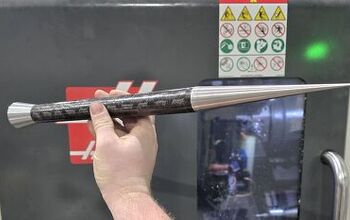The Russian GP-46 40x46mm Grenade Launcher

A recent development in the Russian GP under-barrel grenade launcher series is the GP-46, part of Kalashnikov Concern's export series of weapons chambered in NATO calibers. Chambered in NATO 40×46mm low-velocity (LV) ammunition, this launcher is introduced alongside the new AK-19 assault rifle chambered in 5.56x45mm NATO. In today's geopolitical arena, this is for those customers wanting to balance their friendship between two global superpowers.
The Nades
The 40x46 low-velocity grenade round has been used for over half a century. In the 1950s, the United States was developing a weapon system and high-explosive grenades to increase the lethality of infantrymen, something better than rifle grenades. The result was the 40x46 low-velocity grenade and the M79 standalone, single-shot launcher. The development of this program began in 1953, and the M79 was finally adopted in 1960. The grenades achieved a muzzle velocity of approximately 250 feet per second, and their maximum effective range is around 400 meters.
The 40x46mm rounds utilize a high-low propulsion system. Rheinmetall initially developed this high-low pressure concept during World War II. When the round is fired, the primer ignites the propellant in the high-pressure chamber, generating approximately 35,000 pounds per square inch of pressure. This pressure then expands through vent holes into a cup, causing a rapid pressure drop to around 3,000 psi, resulting in over a 90 percent reduction in pressure. This design produces manageable recoil, comparable to a shotgun, and operates at a lower pressure, allowing aluminum barrels to be used.
As the projectile is fired at a speed of 250 feet per second, the rifling inside the barrel imparts a right-hand spin to the grenade at a rate of 37,000 revolutions per minute. This spin, combined with the initial setback upon firing, activates the fuse in the projectile.
Russian Grenade Production
JSP NPO Pribor, a Moscow region-based company, locally produces NATO 40x46mm low-velocity grenades. The Bogorodsk branch of JSC NPO Pribor (Noginsk) is one of Russia's leading manufacturers of small-caliber ammunition and explosives. It also produces electronics, tools, and dies, including the VOG-30D, an extended-range 30mm grenade.
The GP-46 under-barrel grenade launcher can be attached to any AK-based weapon and mounts similarly to other grenade launchers in the GP series. Considering the current situation in Ukraine, utilizing the GP-46 alongside the large quantities of captured Western aid would be wise.
The GP-46
The grenade launcher features a steel barrel and can be configured for loading from the left or right side. It has an automatic safety catch to eliminate the risk of firing when the launcher is not connected to the rifle or the standalone unit. This safety lever is located at the rear of the launcher’s body.
The controls are fully ambidextrous, including both the safety and the trigger. A unique feature of this design is that the trigger is a lever positioned midway down the weapon, specifically designed to be activated by the operator’s thumb from either side. The safety utilizes HK-style pictograms, making operating easier regardless of the user's language.
The grenade launcher ladder sight is graduated to 400 meters in 50-meter increments and features an adjustable front sight. This design is standard for the GP series. A range scale is also located on top to facilitate range estimation, a feature also found on the GRP-20 grenade launcher.
The GP-46 easily mounts, like all other GP series under-barrel grenade launchers. The grenade launcher is attached to the rifle via the accessory lug on the gas block. A rear automatic safety on the GP-46 prevents it from firing when not connected to the rifle or stand-alone unit; unlike traditional GP series grenade launchers, the GP-46 indexes on the receiver to disengage the safety when mounting the launcher to an AK. This safety can be disengaged as a stand-alone shoulder stock is installed. Notably, there is a significant divergence in preferences within the US Army, with my experience where some leaders advocate for weapon-mounted configurations. In contrast, others prefer a stand-alone setup with the M320s.
Weighing just 3.3 pounds (1.5 kg) and measuring 14.9 inches (380 mm) in length, the GP-46 has a rate of fire of 5 to 6 rounds per minute, which is one round less than the M320's rate of 5 to 7 rounds per minute. This similarity in performance is expected due to their shared design concept. However, the GP-46 uses cased grenades, resulting in a lower rate of fire compared to the traditional GP series, which employs caseless VOG grenades and can achieve around 20 rounds per minute.
There is no information regarding the GP-46's capability to use medium-velocity 40x51mm ammunition. This type of ammunition is designed to extend the effective range from 400 meters with the 40x46 LV to 800 meters. The MEI Mercury medium-velocity 40mm ammunition also achieves a similar range of 800 meters. The GP-46 features a steel barrel and it is highly likely that it can accommodate medium-velocity ammunition.
The GP-46 introduces a new product to Kalashnikov Concern's export portfolio. This firearm showcases the company's ability to adapt to Western trends by offering a new caliber option. Its unique features could help Kalashnikov Concern maintain competitiveness in the global arms market.

Lynndon Schooler is an open-source weapons intelligence professional with a background as an infantryman in the US Army. His experience includes working as a gunsmith and production manager in firearm manufacturing, as well as serving as an armorer, consultant, and instructor in nonstandard weapons. His articles have been published in Small Arms Review and the Small Arms Defence Journal. https://www.instagram.com/lynndons
More by Lynndon Schooler


















![[SHOT 2025] March Scopes Displays PRS-optimized Scope](https://cdn-fastly.thefirearmblog.com/media/2025/01/23/10591/shot-2025-march-scopes-displays-prs-optimized-scope.jpg?size=350x220)











Comments
Join the conversation
Calling Russia a "global superpower" is very generous.
Nice ACR style stock. I want one for my AK.